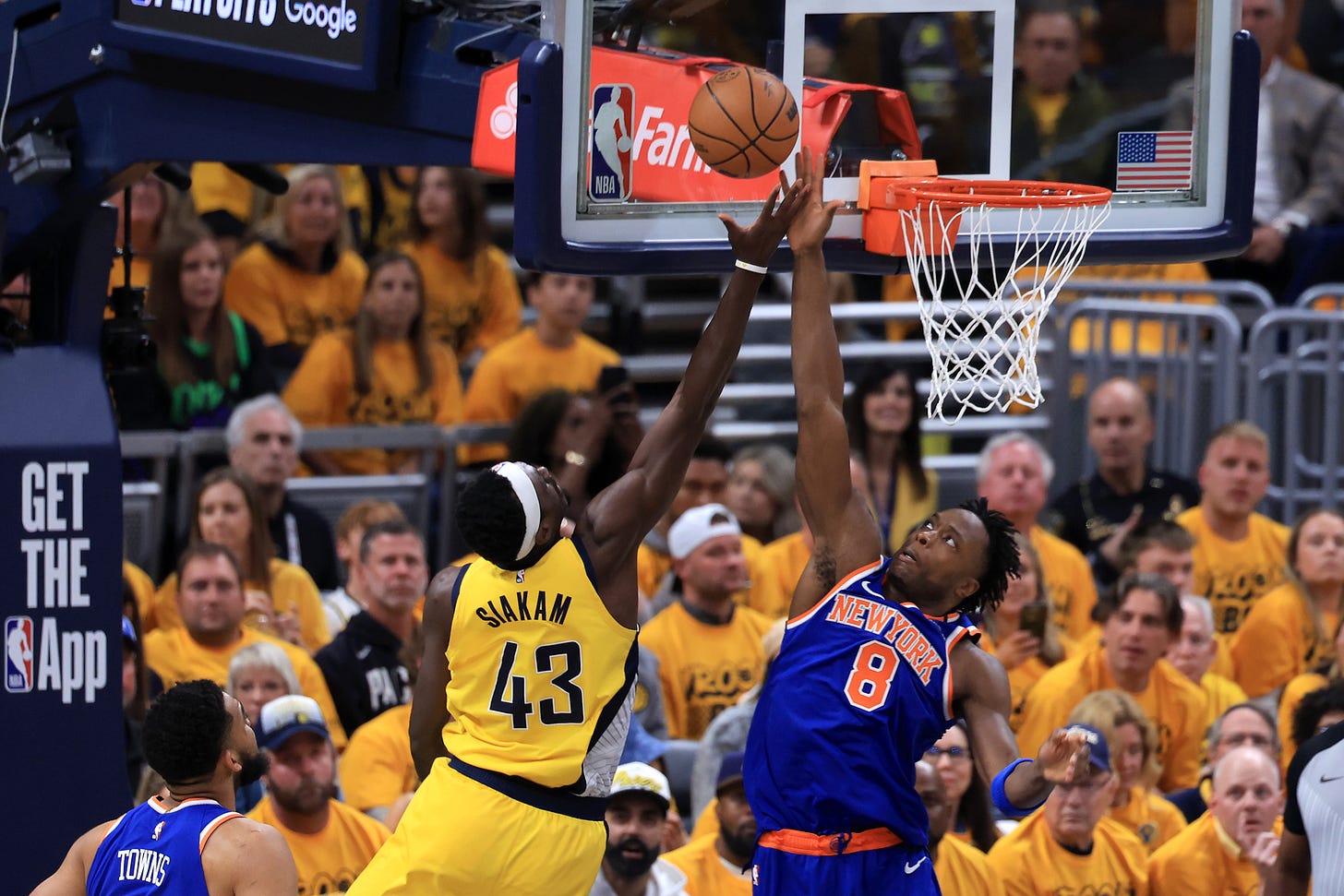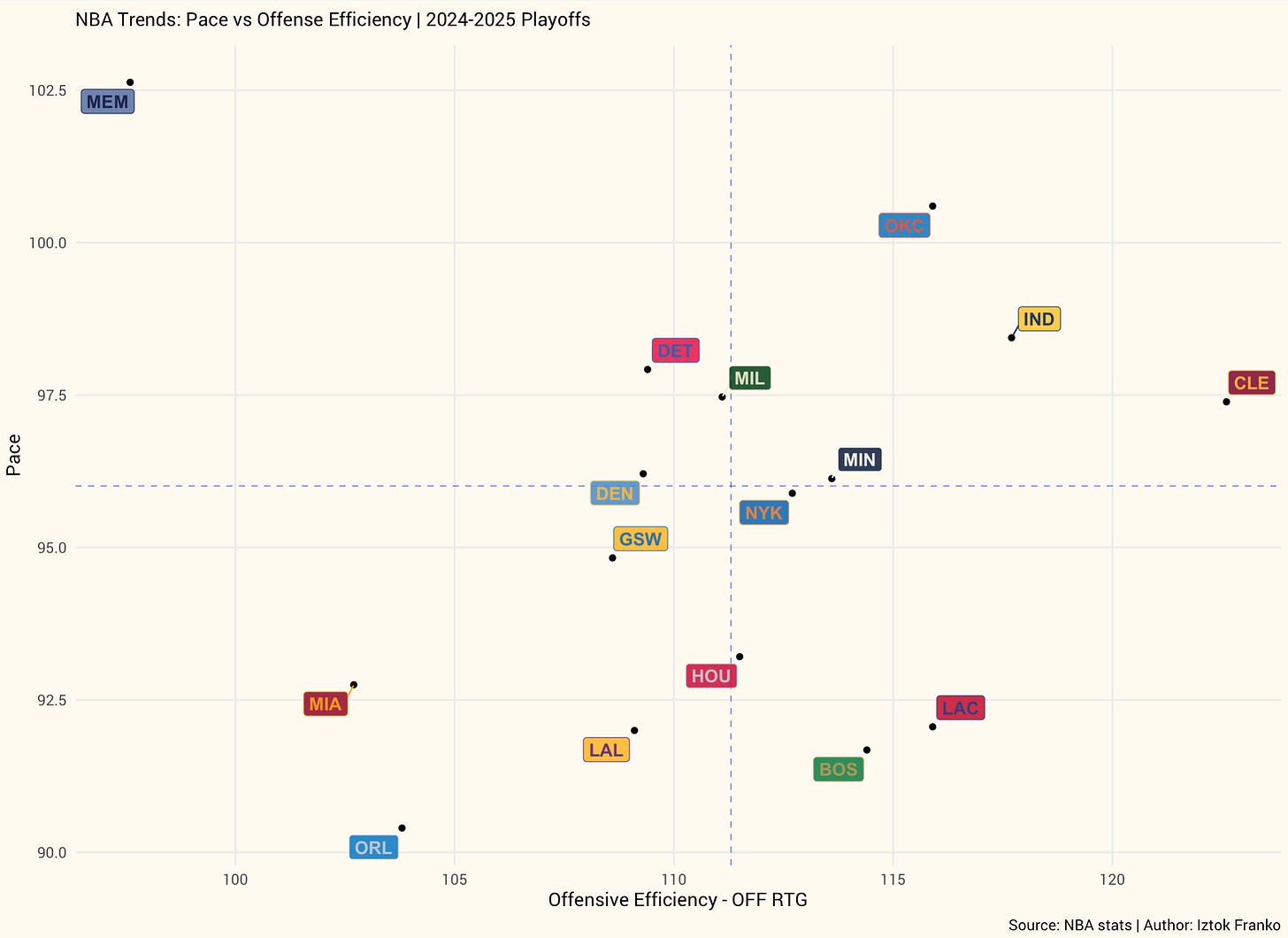NBA Trends, Part III: The Rise of Skilled Size
Playoff lessons, counters to pressure, and the evolution of offense
This is the third part in the NBA Trends series, where I focus on playoff storylines and bigger-picture league trends. Part I was about the rise of speed, aggressiveness and athleticism, especially on the defensive end. Part II looked at the return of offensive rebounding as a weapon.
I get it. Once the season wraps, most fans want to dive into team needs, roster questions and especially possible upgrades through trades or free agency. And we’ll get there. But I’ve always preferred a structured, top-down approach. Before we get to concrete names, I think it’s important to understand the context — the trends shaping the league and influencing how teams are built. That’s what this series is about.
Reflecting on Part I got me thinking. If defenses are getting faster, longer, more aggressive and athletic, what’s the best way to counter? I went back to the data, looked for key themes from the playoffs, and talked to a few friends who follow the league closely and whose opinions I really respect. What follows in Part III is a mix of what I found and how I see it—but as always, I’d love to hear your thoughts too.
As always, I will add Lakers and Mavericks context by examining where they stand in all of this and how these trends could influence their team-building decisions. For this series, I have parsed the last 20 years of game logs, covering more than 50,000 regular season and playoff records, including box score, advanced, and four factor data. I also went through the last 12 seasons of available tracking data.
Today’s highlights:
Fight speed with speed 📈
Drives replacing the simple and slow entry passes 📈
Fight length with size, Sam Presti's blueprint
Decision making moving up 📈
Adapting or falling behind? Are the Lakers and Mavericks built for it?
1-Fight speed with speed 📈
In Part I, I wrote about the new era of speed, aggressiveness and athleticism. It was mostly in a defensive context, watching teams like OKC, Indiana and Minnesota pressure the ball and fly all over the court, disrupting with their length and/or speed.
One of the counters to beat aggressive half-court defenses that make it so difficult to score is to not get there in the first place. The rise of pace was another trend I wrote about, and now the two fastest teams in the playoffs (second and third to be exact, since Memphis was first) will clash in the Finals. Indiana is killing teams in transition and early offense, pushing the ball at every opportunity, while pressing full court on the other end. OKC’s historically stifling defense is forcing turnovers, which unlocks their transition game.
These playoffs are a win for pace, for early offense attacks, for deliberate and fast ball movement and passing. The physicality that’s allowed, along with the rise of zone defenses, has made set defenses very difficult to beat. Forcing switches and relying on stagnant isolation play doesn’t work as well anymore. The best way to attack is before the defense gets set.
Ball movement and passing is another way to beat speed. I remember one of the coaches here always saying, “the ball is faster than the fastest player.” Teams that swing the ball fast, from side to side, and have a high assist ratio—like Indiana, Denver, Cleveland and OKC—have been among the best offenses this season, both in the regular season and the playoffs.
2–Drives replacing the simple and slow entry passes 📈
Now, if we look at passing in more detail, there are two interesting trends. One I already mentioned: overall assist rate (AST%) is going up. But at the same time, the total number of passes per 100 possessions in an NBA game is actually going down.
However, if we look more closely at the Second Spectrum passing tracking data, we see that slower, lower-tempo passes such as post entries, elbow entries or simple perimeter passes are in decline. On the other hand, outlet passes, skip-aheads, handoffs and kickouts, the ones that create tempo, have stayed at similar levels or even increased.
If you listen to NBA coaches talk, you’ll often hear about paint touches as one of the most important metrics they track on offense, and how possessions with a paint touch are usually much more efficient. In today’s pace-and-space era, the way to get the ball into the paint and force the defense to shift isn’t by throwing it into the post. It’s by attacking off the dribble—either with a drive in early offense or out of a quick handoff in the flow of the offense.
The ability to drive the ball and get into the paint has become a premium skill in the modern NBA, with players like Shai Gilgeous-Alexander, Tyrese Haliburton, Jalen Brunson, Donovan Mitchell, Anthony Edwards, Luka Dončić, Cade Cunningham and T.J. McConnell leading the charge.
3–Fight length with size, Sam Presti's blueprint
Another way to generate easier or extra looks on offense against physical and aggressive defenses is offensive rebounding, a rising trend I wrote about in Part II of this series.
However, more size inside and on the glass is not the only shift. What we’re seeing is an ongoing increase in size at the primary, secondary and even tertiary levels of creation and decision making (more on secondary and other levels in the next point).
OKC Thunder GM Sam Presti spoke about the combination of size and decision making after last year’s draft, and in my opinion, the rise and spread of skill across all positions in today’s positionless basketball is one of the key trends and themes of these playoffs.
The themes are pretty consistent with other nights that we've had draft-wise. High processing on offense, high skill level with regards to vision and passing...and that's combined with big players…People that can handle the ball, make decisions with the ball, are pretty big for their position [and] are interchangeable.
Guys that are big for their position that process the game well, those guys can play pretty much all over the floor in different combinations. So we value those skillsets probably more than trying to replicate a specific role or anything like that… I don’t think you can have enough people that can make decisions on the court, and when you combine that with size, it definitely increases the effectiveness or the probabilities of those decisions being good. — Sam Presti
Keep reading with a 7-day free trial
Subscribe to digginbasketball to keep reading this post and get 7 days of free access to the full post archives.












